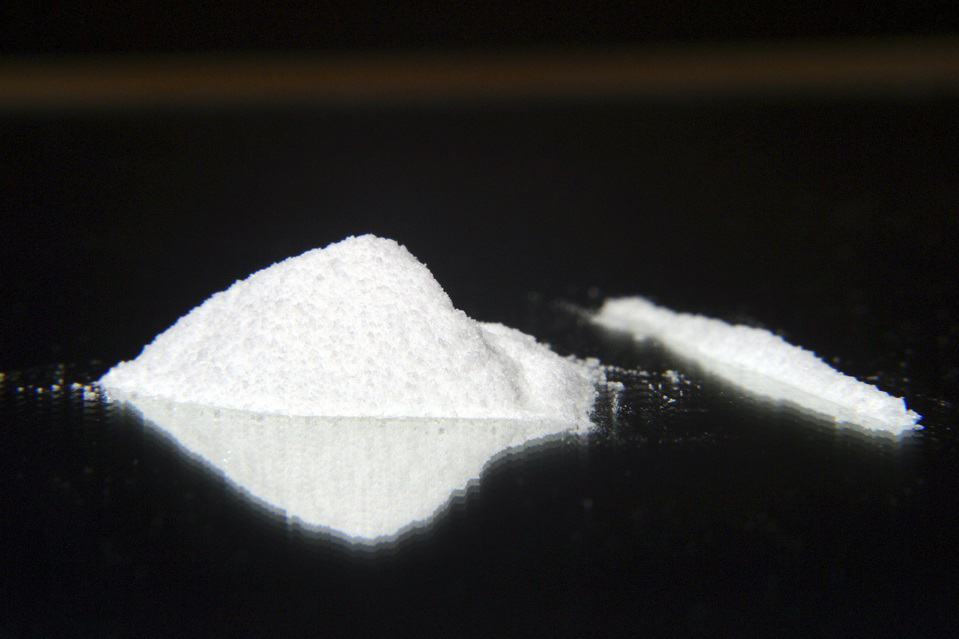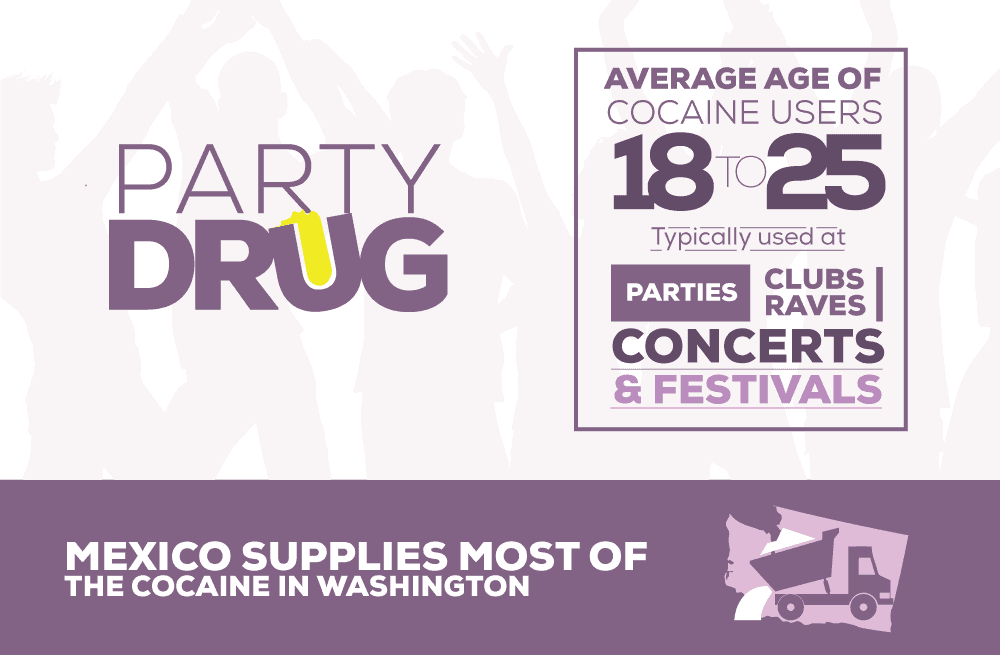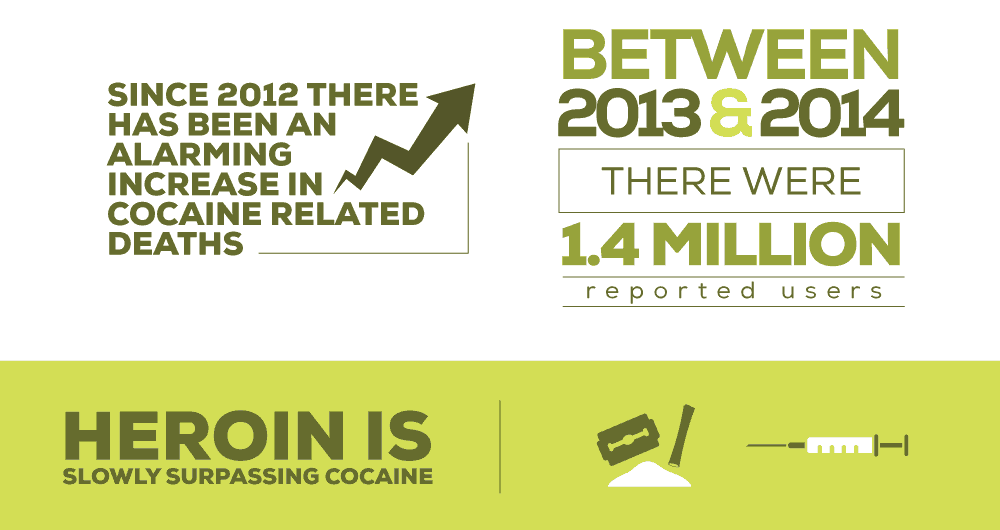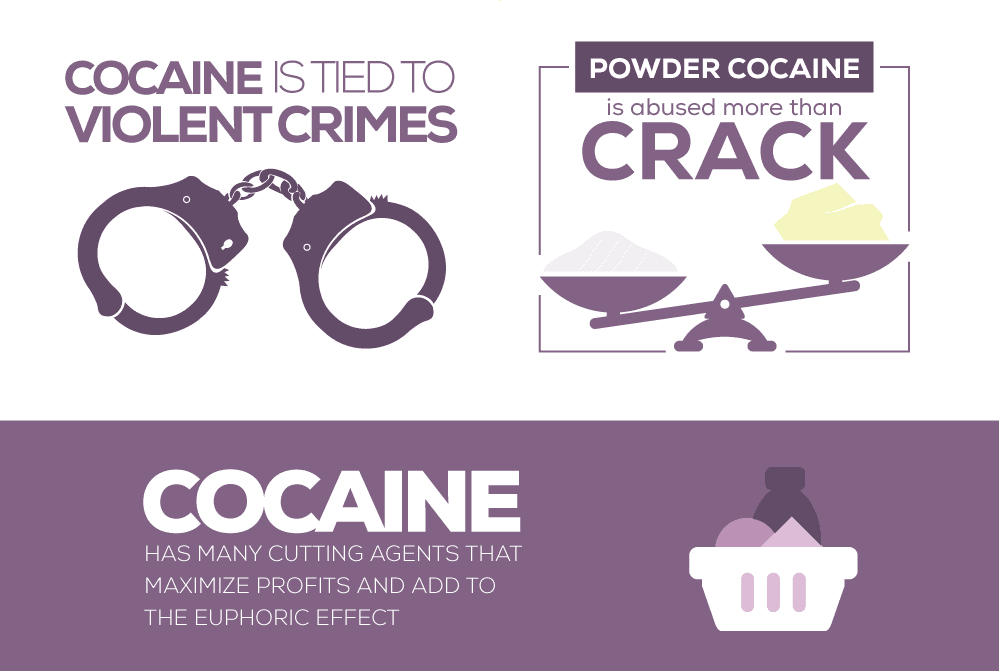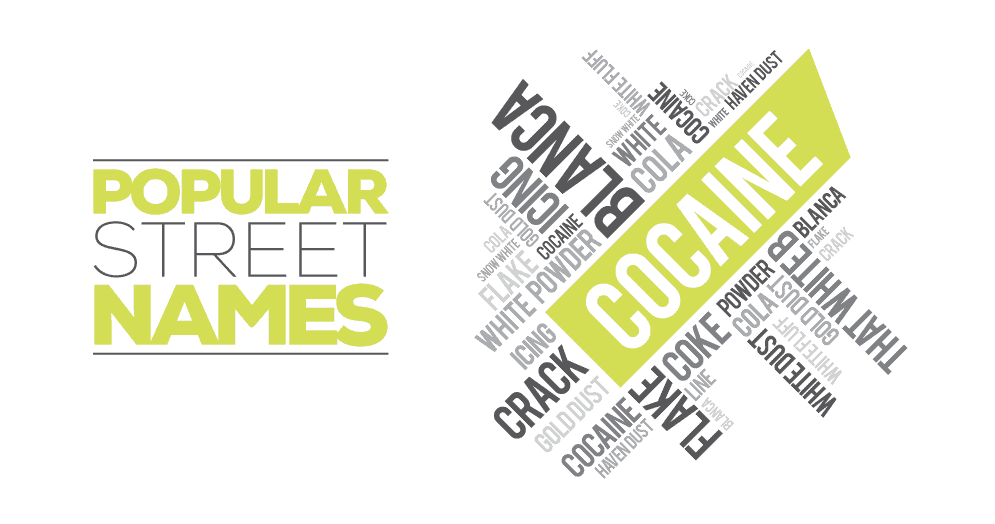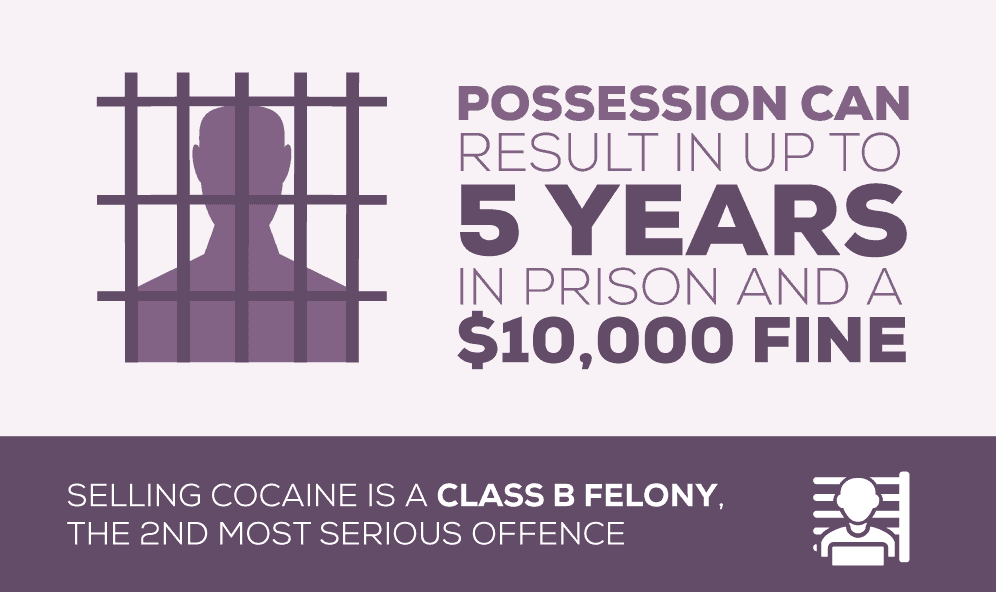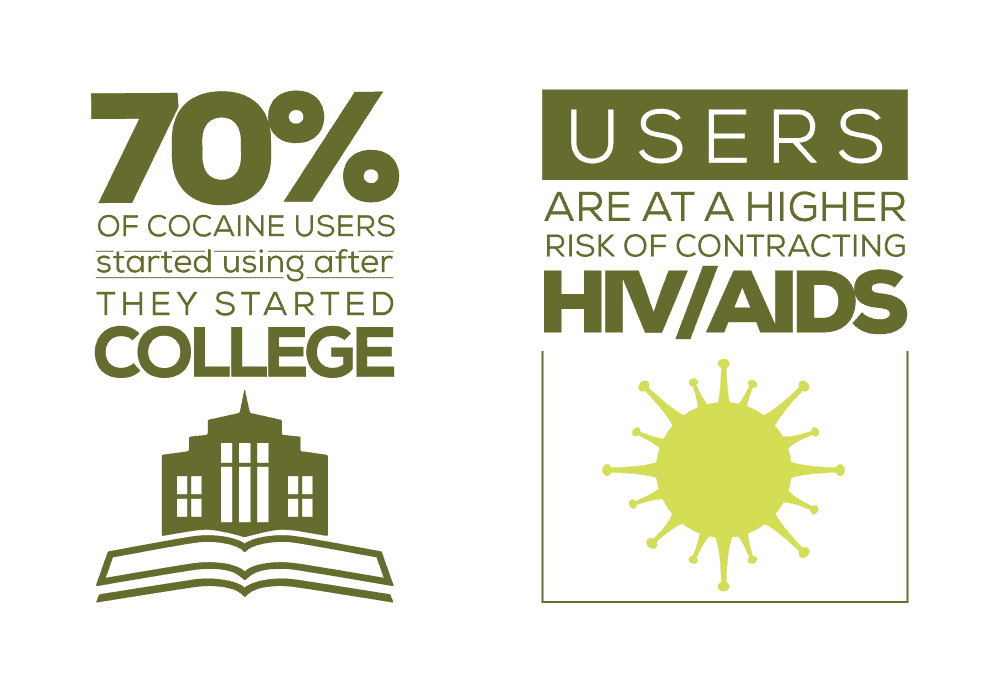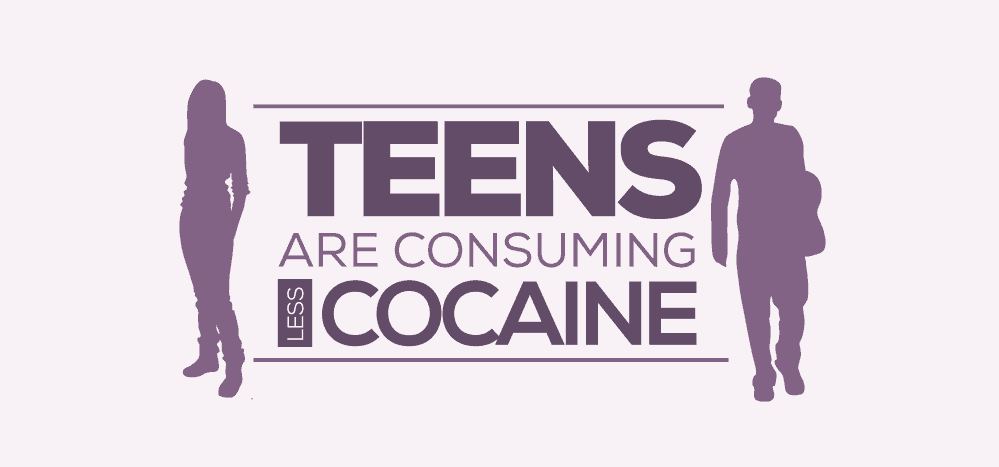In WA State, cocaine use has been on a steady decline. According to the National Institute on Drug Abuse (NIDA), “Primary cocaine treatment admissions continued to slowly decline for most age groups in the first half of 2013, compared with previous reporting periods. For example, the proportion of primary cocaine admissions in the 30–44 age group declined from 11 percent of all admissions in that age group in 2011, to 10 percent in 2012, and to 8 percent in the first half of 2013.” Those numbers are a reassurance that it’s not being used as often. Unfortunately, heroin rates have been rising so dramatically as to nullify this “win” for WA state. Here are some interesting facts about cocaine use today in WA State and around the world.
1. Cocaine a popular drug among party-goers in Washington State.
Cocaine in the U.S. is used most among adults aged 18 to 25, with about 5% of Americans in this age group admitting the current use of the drug. Cocaine was often used as a “club drug.” These are drugs that are used at rave-like parties, nightclubs, and concerts. This was especially true of cocaine in the 1970s and 80s. Still, the use of the drug in social environments persists due to their stimulant effects.
2. Most of the cocaine in WA State comes from Mexico.
Cocaine is an extraction of the leaves of the Erythroxylon coca bush, which is indigenous to South America. Most of the cocaine available in the U.S. is from the country of Colombia, but for WA State, it usually comes from Mexico. It is the second most trafficked drug in the world. According to Fox News, “The 2016 International Narcotics Control Strategy Report (INCSR) found that around 90 percent of cocaine coming to the U.S. during the first half of 2015 made its way through the Mexico and Central America corridor. That number is up from 86 percent in 2014 and 80 percent in 2010.”
Powdered cocaine is often transported through Seattle to drug markets in other States and Canada. Transportation routes for cocaine transiting Washington include I-5 to Canada and I-90 and US 2. These routes connect Washington to Idaho, Montana and North Dakota.
3. Deaths from cocaine increased from 2012 to 2013.
According to NIDA, “While drug-caused deaths attributed to cocaine were down from a peak of 54 such deaths in the first half of 2006, the number of drug-caused overdose deaths involving cocaine continued to be a concern. These deaths increased from 24 deaths in the first half of 2012 to 35 deaths in the first half of 2013.”
4. Cocaine use is down or steady overall.
NIDA says, “According to the National Survey on Drug Use and Health (NSDUH), cocaine use has remained relatively stable since 2009. In 2014, there were an estimated 1.5 million current (past-month) cocaine users aged 12 or older (0.6 percent of the population). Adults aged 18 to 25 years have a higher rate of current cocaine use than any other age group, with 1.4 percent of young adults reporting past-month cocaine use.”
The hope is that this number continues to decline over time. Of course, that does lead to the discussion of the newest, most dangerous popular drug: heroin.
5. Cocaine seems to have been replaced by heroin as a popular drug.
Although cocaine use is steady or trending downward in WA State and the U.S. as a whole, heroin use is up. In WA State, reports prove that “The average annual number of deaths from 2000-2002 was 310, from 2009-2011 it was 607. The majority of deaths involved Rx-type opiates from 2000-2011. Heroin and unspecified opiates increased in the period from 2009-2011. King County data for 2012 indicate 84 heroin involved deaths, up from 49 in 2009, with all of the increase among those under 30.”
6. Cocaine use is tied to violent criminal activity in WA State.
According to the National Drug Intelligence Center, “Violent criminal activity in Washington has been linked to cocaine distribution, particularly the distribution of crack cocaine. Numerous street gangs in Washington that distribute powdered cocaine and crack also commit violent crimes such as assault, bank robbery, carjacking, drive-by shooting, home invasion, and homicide, some of which are related to their cocaine distribution operations.”
7. Powdered cocaine is abused more than crack cocaine.
Crack is smoked while cocaine is inhaled or “snorted.” Powdered cocaine is generally easy to purchase in WA State. Crack cocaine is limited mostly to the highly-populated, urban areas such as Seattle, Tacoma, and Spokane.
Crack cocaine is the crystalline form of cocaine. It is purer and stronger than powdered cocaine. It is sold so cheaply that anyone with a small amount of pocket money can afford to purchase it. In the United States, crack cocaine was the drug of choice for 178,475 people who were admitted to treatment in 2006. That was 71% of all primary cocaine admissions to treatment in 2006.
8. Cocaine is used more by men than by women.
The Office of Drug Control Policy says, “Men are more likely to use cocaine than women, as the drug is associated with living dangerously and wildly, but the gender gap is beginning to decrease. According to 2008 statistics, there are approximately 700,000 new male users each year in the U.S. and about 500,000 new female users.” Men are also more likely to feel the euphoric and dysphoric effects of the drug.
For women, “Babies born to mothers who used cocaine during the pregnancy tend to be born prematurely, have low birth weights, and suffer from brain damage. The risk of spontaneous abortion is also greatly increased with cocaine use during pregnancy.”
9. Cocaine is usually cut with a variety of powders.
Drug dealers often mix it with things like cornstarch, talcum powder, or flour to increase profits. They might also mix it with other drugs such as an amphetamine. This can be extremely dangerous. Besides the fact that one may be inhaling flour or talcum powder, the dangers of ingesting a more dangerous substance such as amphetamines are extremely risky – possibly deadly.
10. Cocaine has many names that might surprise you.
Cocaine is known by MANY names. Here are just some of the popular names: Blanca, crack, flake, gold dust, haven dust, line, white, that white B, snow-white, white powder, white fluff, icing, white dust, coke, coca, cola, and powder. In the 70s and 80s, at the height of cocaine’s popularity, it was known by different names: Girlfriend, Love Affair, King’s Habit, Pimp, White Pimp, Movie Star Drug, Star-Spangled Powder, Studio Fuel, Late Night, and Society High.
11. Penalties for being caught with cocaine is harsh.
Just a simple possession charge can get a penalty of up to five years in prison and $10,000 in fines. Some people charged with possession may qualify for court-mandated treatment. The minimum requirements are: you would benefit from treatment; you are not a sex offender, and you’ve never been convicted of a violent offense.
12. Penalties for being charged with the selling or manufacture of cocaine are even harsher.
Selling cocaine is a Class B felony. If convicted, you can get up to 10 yrs. and/or $25,000 for less than 2 kilograms of cocaine. If over 2 kilograms, the penalty is $100,000 and $50 for each gram in excess of 2 kilograms. Subsequent offense: up to double penalties. Sale within 1000 ft. of school results in double penalties. Selling to a minor is a Class C felony.
13. College students are especially likely to use cocaine.
Besides it being a party drug, cocaine is especially popular among college students. In 2016, one young college student was caught selling cocaine at Washington State University. Law enforcement officials urge parents of students not only to discuss the dangers of alcohol but of hard drugs as well. Reports show that 70% of cocaine users started using after they started college. Unfortunately, the withdrawal symptoms can be so difficult to deal with that students continue to use cocaine. Over time, they require higher and higher doses to feel the drug’s effects.
14. Cocaine is still a very popular club drug in Europe.
Cocaine is Europe’s most popular stimulant. According to the European Monitoring Centre for Drugs and Drug Addiction, “It is estimated that about 2.3 million young adults aged 15 to 34 (1.9 % of this age group) used cocaine in the last year. Many cocaine users consume the drug recreationally, with use highest during weekends and holidays. Data from wastewater analysis carried out in a 2014 European multi-city study confirm daily differences in use. Higher concentrations of benzoylecgonine — the main metabolite of cocaine — were found in samples collected during the weekend.”
Cocaine users like the drug because it can make them feel more sociable. The high is also popular due to the feelings of euphoria and self-confidence it gives users. Unfortunately, things can go bad after prolonged use like difficulty feeling emotions, sadness and depression. People can become surprisingly tolerant of the physical discomforts one has when using the drug. These physiological side effects include nausea, increased heart rate, sweating and an inability to regulate temperature.
Like the U.S., the prevalence of cocaine use is on an overall downward trend. However, 800 deaths due to cocaine overdose were reported in 2013 in Europe, and 85% of users who received treatment were men in their early 30s.
15. Users are at a higher risk of contracting HIV/AIDS.
NIDA’s research says, “Studies that examine patterns of HIV infection and progression have demonstrated that cocaine use accelerates HIV infection. Research indicates that cocaine impairs immune cell function, promotes replication of the HIV virus, and potentiates the damaging effects of HIV on different types of cells in the brain and spinal cord, resulting in further damage. Studies also suggest that cocaine use accelerates the development of NeuroAIDS, neurological conditions associated with HIV infection. Symptoms of NeuroAIDS include memory loss, movement problems, and vision impairment.”
16. Even though it’s pretty easy to obtain, fewer and fewer teens try cocaine in WA State.
Drugpolicy.org states, “According to government surveys, eight percent of high school seniors reported using cocaine at least once during their lifetime. This is markedly lower than the peak of 17 percent for the senior class of 1985. In terms of crack, 3 percent of eighth-graders, 4 percent of tenth graders, and 4 percent of twelfth graders reported using the drug at least once during their lifetime in the same survey. In 2010, 23 percent of eighth-graders, 32 percent of tenth graders, and 45 percent of twelfth graders reported that crack was ‘fairly easy’ or ‘very easy’ to obtain.”
Drug treatment centers are readily available to deal with cocaine rehab. Like so many addictions, there is also the need to treat co-occurring disorders. There is hope. If you or someone you love is addicted to cocaine, don’t wait until it’s too late. Get them the help they need.
What Did you Think About This Blog?
Give it a Rating!

